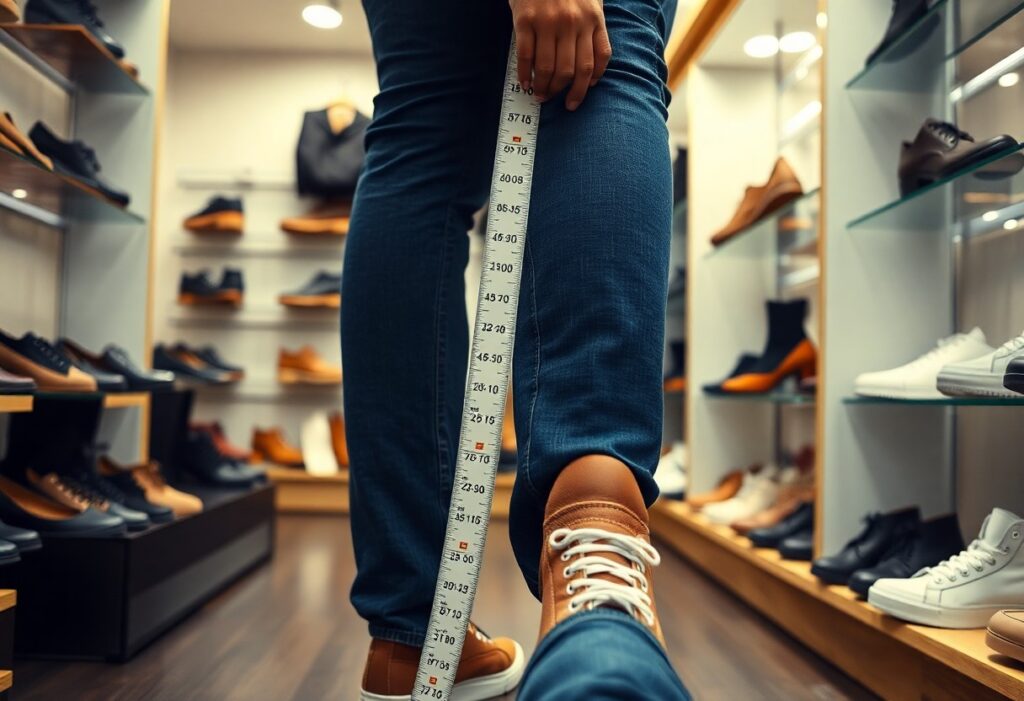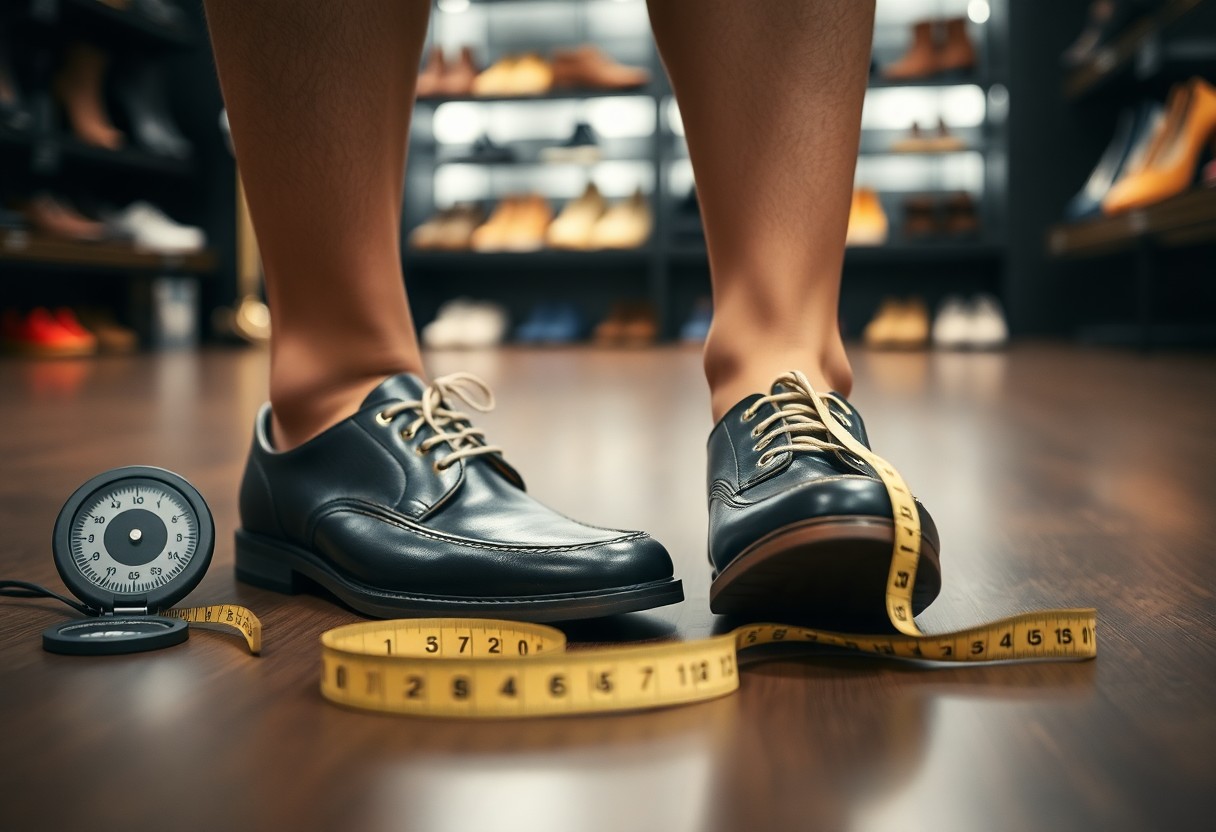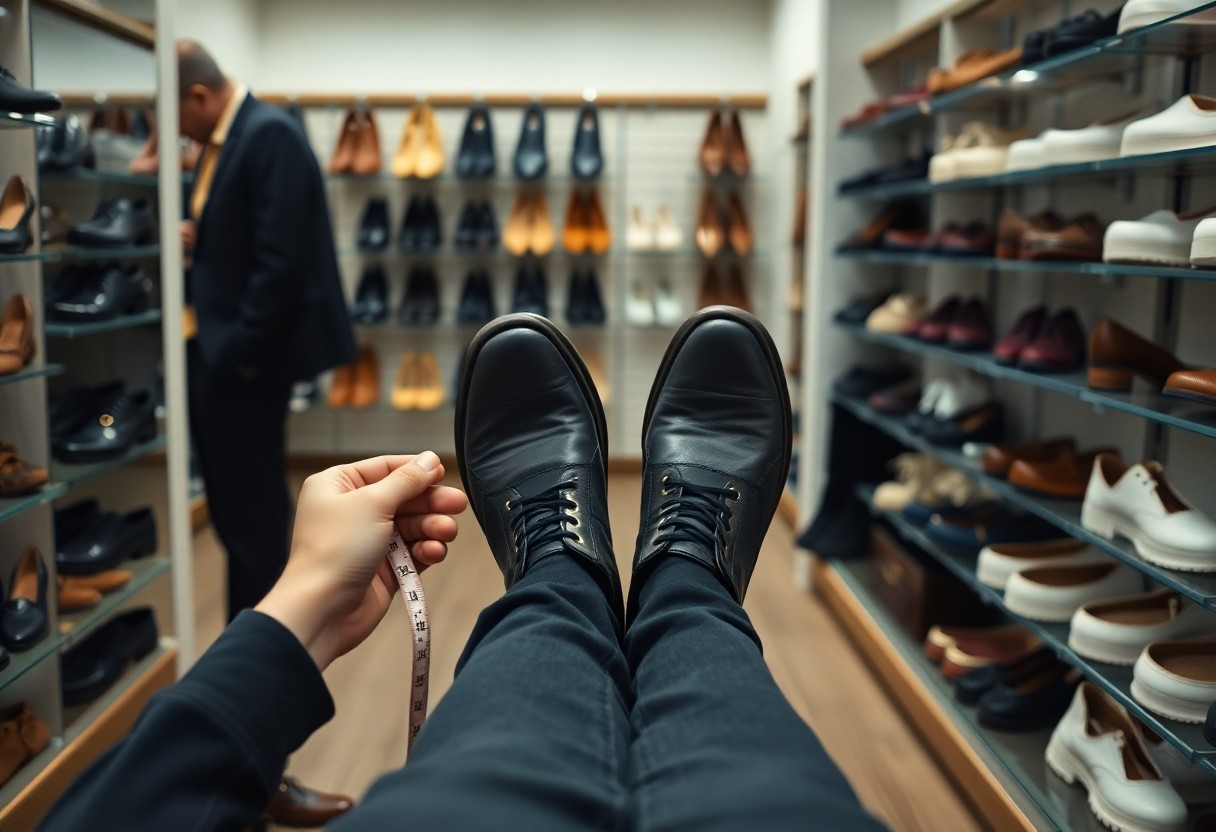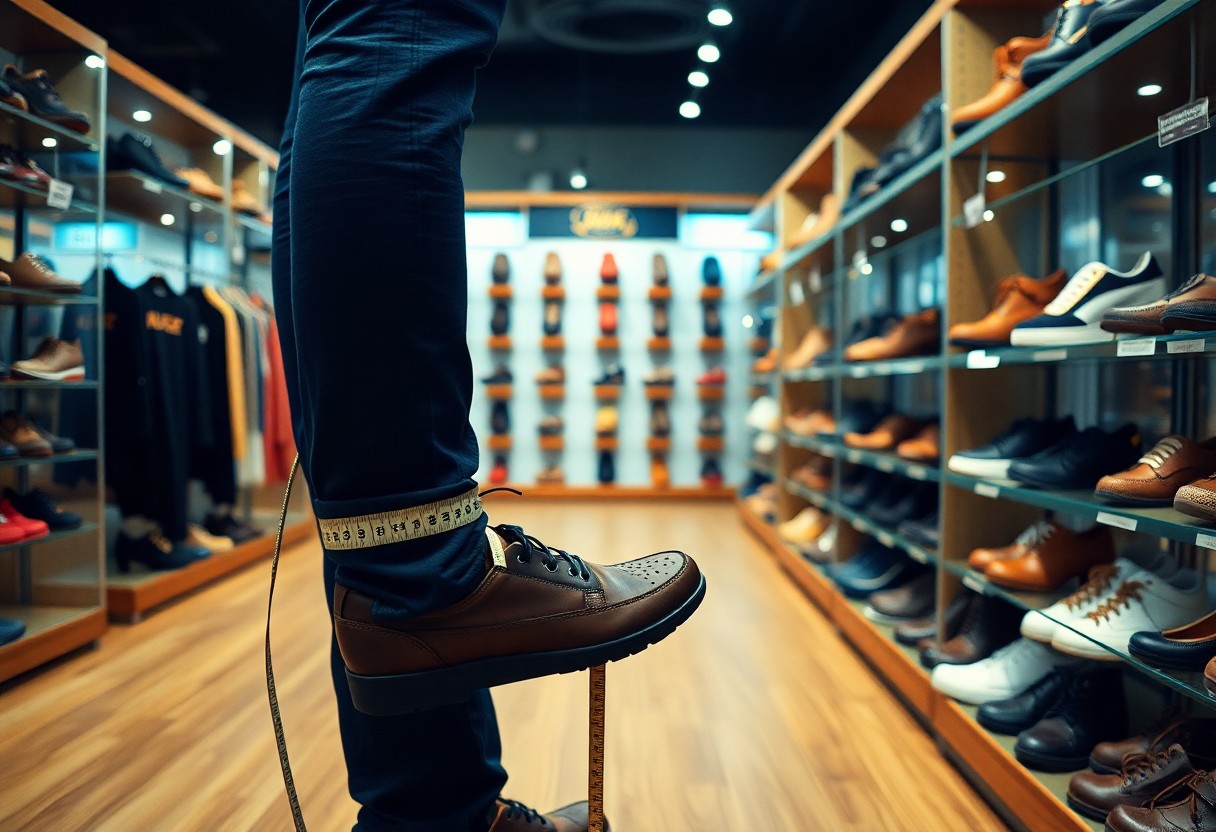
Grasping the complexities of selecting the right shoe size is vital for promoting foot health. Wearing improperly fitting shoes can trigger a spectrum of issues, ranging from minor blisters to serious, long-lasting joint harm. Since our feet support the entirety of our body, ill-fitting shoes can severely disrupt daily comfort, mobility, and overall wellness. Recognizing the signs of incorrect shoe fit is paramount to preserving your foot health. Studies show that a staggering 75% of individuals face foot issues linked to improper shoe sizing. This extensive guide is designed to provide you with essential insights on assessing your current footwear and choosing the ideal size that caters specifically to your unique foot shape.

Identify Key Indicators of Ill-Fitting Footwear
Taking charge of your foot health starts with recognizing the key indicators often linked to ill-fitting shoes. Research indicates that 60% of individuals wear shoes that are not an appropriate size, leading to various foot-related complications. Proper footwear must allow for adequate space for your toes to move, provide the right arch support, and maintain consistent comfort throughout your daily activities. Utilizing shoes that do not fit correctly can inflict lasting damage upon your feet and even alter the way you walk, which can have further ramifications on your overall health.
Spotting Physical Signs of Foot Discomfort
Common physical signs that your shoes may not fit properly include blisters, calluses, and corns that develop on your feet. You might observe redness or bruising on your toes, particularly after prolonged periods of walking or standing. Additionally, if your toenails seem damaged or discolored, it could be a sign of improper shoe fit. These symptoms serve as clear indicators that your shoes may be too tight or too loose, prompting an urgent reassessment of your size to ensure optimal fit and comfort.
Assessing Comfort Levels to Ensure Proper Fit
Contrary to common misconceptions, new shoes should feel comfortable immediately upon wearing. Your toes should have ample space to move without restriction, and your heel should fit snugly without slipping as you walk. Experiencing pain or numbness in your feet is never normal and serves as a clear warning of improper fit. Always verify that your shoes provide sufficient arch support and cushioning that aligns with your foot's specific requirements.
To conduct a thorough comfort evaluation, try on your shoes at different times of the day, as your feet naturally swell and change shape. When trying on shoes, aim for a gap of about 3/8 to 1/2 inch between your longest toe and the shoe’s front. Walk on various surfaces to assess comfort levels adequately. If you encounter any discomfort or pressure points, consider experimenting with different sizes or styles to achieve the best possible fit.

Steps to Accurately Measure Your Feet for the Perfect Shoe Size
Determining the correct shoe size relies heavily on accurately measuring both feet. It's important to remember that foot sizes can differ by as much as half a size, and foot dimensions can change throughout the day. For the most accurate results, measure your feet in the afternoon when they are likely to be somewhat swollen, ensuring that you achieve the most comfortable fit possible.
Employing Professional Techniques for Foot Measurements
Professional shoe fitting typically utilizes a Brannock Device, which accurately measures your foot’s length, width, and arch length. This comprehensive three-dimensional measurement is crucial for identifying your precise shoe size. A trained shoe specialist will measure both feet while you stand, considering weight distribution and the natural spreading of your feet under load.
Effective At-Home Methods for Sizing Your Feet
To measure your feet at home, place a piece of paper on a flat surface and trace the outline of your foot while standing. Measure the distance from your heel to your longest toe and the width at the widest part of your foot. To ensure sufficient space for toe movement and comfort, add an extra 3/8 inch to your measurements.
For enhanced accuracy in your at-home measurements, it’s recommended to measure your feet in the evening and while wearing the socks you plan to use with your new shoes. Ensure that there’s a thumb's width of space between your longest toe and the shoe’s tip; this allowance helps prevent toe injuries and supports natural foot movement while walking.
Common Pitfalls to Avoid When Choosing Shoe Sizes
Many people mistakenly believe they know their correct shoe size, yet studies reveal that up to 60% of individuals wear shoes that are not the correct size. Frequent mistakes include clinging to the same shoe size for years, neglecting width measurements, and overlooking size discrepancies between the two feet. These errors can lead to serious foot issues and significant discomfort.
Recognizing Size Variations Across Different Shoe Brands
Variations in sizing among different shoe brands can significantly affect your comfort levels. For example, a size 8 from one brand might fit like a size 9 from another due to varying manufacturing standards and design philosophies. Always try on shoes regardless of the size indicated on the label, as these discrepancies can have serious implications for your foot health and overall well-being.
The Importance of Timing When Shopping for Shoes
The timing of your shoe shopping is essential. Your feet naturally swell throughout the day, expanding by as much as half a size larger by evening. Shopping in the afternoon or evening offers the best chance to find a fit that meets your daily needs.
Moreover, your feet may expand during physical activities or in warmer weather. Purchasing shoes too early in the day may result in tight-fitting footwear that becomes uncomfortable as the day progresses. Always ensure that there is a thumb's width of space between your longest toe and the shoe’s tip when trying on new shoes in the afternoon.

The Significant Health Effects of Wearing Properly Fitting Shoes
The shoe size you select can have a major impact on your overall health. Wearing ill-fitting shoes can affect your entire body, from your toes to your spine. Research indicates that 72% of individuals suffer from foot-related health issues as a result of incorrect shoe sizes, which can lead to altered walking patterns and subsequent posture problems.
Immediate Effects of Wearing Shoes That Don't Fit
In terms of immediate comfort and health, wearing shoes that are the wrong size can lead to blisters, corns, and painful pressure points. You may also experience foot fatigue, ankle strain, and diminished balance. Such issues can disrupt your daily activities, causing discomfort while walking, with 85% of individuals reporting immediate discomfort when wearing poorly fitting shoes.
Long-term Health Consequences of Improper Shoe Sizes
Prolonged use of shoes that do not fit properly can lead to permanent foot deformities, including conditions such as bunions, hammer toes, and plantar fasciitis. Changes in your walking style may occur as you compensate for discomfort, potentially resulting in knee, hip, and back issues. Research shows that 60% of chronic foot problems can be traced back to wearing ill-fitting shoes.
The consequences of wearing the wrong shoe size extend beyond foot health. You may experience poor posture, reduced mobility, and chronic pain. Medical studies suggest that appropriate shoe fit can prevent up to 80% of common foot issues and significantly enhance your overall quality of life. The shoes you choose today can have enduring effects on your foot health for years to come.
Special Considerations for Different Life Stages and Health Conditions
It’s vital to understand that your feet require careful attention during various life stages and in light of specific health conditions. Factors such as age, weight changes, and certain medical conditions can affect your shoe size. Regularly measuring your feet is essential, as wearing the wrong size can lead to serious foot complications and reduced mobility.
How Aging Impacts Foot Size
Beyond the natural aging process, your feet undergo considerable changes over time. As you get older, your feet may become wider and flatter due to a reduction in elasticity in tendons and ligaments. Research indicates that foot size can increase by half a size every decade after age 40. Therefore, it’s a good practice to measure your feet annually to ensure a proper fit.
Health Conditions That Affect Shoe Size
Your health status has a considerable impact on your shoe size. Conditions such as diabetes, arthritis, and edema can lead to significant foot swelling, which may require adjustments in shoe size. If you experience any of these conditions, it is crucial to focus on shoe fit to avoid further complications.
Additionally, certain medications might lead to foot swelling as a side effect. Poorly fitting shoes can exacerbate existing health conditions and introduce new issues. For individuals with diabetes, regular foot examinations are critical, and ensuring shoes offer adequate space and support is essential. Studies have demonstrated that proper footwear can reduce the risk of diabetic foot complications by up to 50%.
Essential Tips for Effective Shoe Shopping
Despite widespread misconceptions, successful shoe shopping demands careful attention to detail. Your foot size can fluctuate throughout the day, making afternoon shopping the most advantageous time when your feet are at their largest. This timing will yield the most accurate fit measurements as your feet naturally expand throughout daily activities.
Crucial Guidelines for Achieving the Right Shoe Fit
Contrary to popular belief, achieving the perfect fit involves more than merely measuring length. Here are some essential considerations to ensure a correct fit:
- Ensure a thumb-width space exists between your longest toe and the shoe tip
- Confirm that arch support is suitable for your foot type
- Try on shoes with your regular socks for the best fit
- Walk around to evaluate heel grip and overall comfort
Any discomfort felt during the initial fitting is likely to intensify with prolonged wear, so addressing these issues at the outset is critical.
Recognizing the Right Time to Replace Your Shoes
It's vital to replace shoes when they show specific signs of wear. Look for worn treads, uneven sole wear, or when you have walked 400-500 miles in athletic footwear.
When your shoes exhibit these warning signs, replace them without hesitation: visible creasing in the midsole, diminished cushioning, or wear in the interior lining. Your feet require reliable support every 8-12 months for daily-wear shoes and even more frequently for athletic shoes. Continuing to wear worn-out footwear can lead to severe foot pain and injury.
Commonly Asked Questions About Shoe Sizing
Q: How can I tell if my shoes are too tight while wearing them?
A: Watch for the following indicators: numbness or tingling sensations in your toes, blisters forming on your heels or toes, and visible red marks on your feet after removing your shoes. Your toes should have enough space to wiggle freely, and your heel should stay secure without slipping during movement. If you experience pressure points or discomfort after wearing shoes for just a few hours, it's likely that your shoes are too tight.
Q: When is the best time of day to measure foot size and try on new shoes?
A: The optimal time to measure your feet and try on new shoes is during the late afternoon or evening. Feet naturally swell throughout the day, reaching their largest size by evening. This timing ensures that you select shoes that will fit comfortably even when your feet are at their fullest. Always remember to measure both feet, as one foot is often slightly larger than the other.
Q: How much space should I allow between my longest toe and the front of the shoe?
A: Aim for approximately 3/8 to 1/2 inch (or thumb width) of space between your longest toe and the shoe tip. This gap permits natural foot movement while walking and helps to prevent toe injuries. Your toes should never touch the front of the shoe while standing or walking. To test this, stand up and slide your finger behind your heel – it should fit snugly without feeling tight.
The Article How to know if you're wearing the right shoe size signs and tips for a perfect fit appeared first on My Shoes Finder
The Article Signs and Tips for Knowing Your Right Shoe Size Was Found On https://limitsofstrategy.com


Your insights on the significance of properly fitting footwear resonate deeply, especially given how often we overlook something so fundamental to our health. Personally, I’ve always been somewhat of a shoe enthusiast, but it wasn’t until I had a painful experience with a pair of stylish yet ill-fitting shoes that I truly recognized the importance of comfort and fit. That experience turned out to be a wake-up call, prompting me to genuinely assess my footwear choices moving forward.